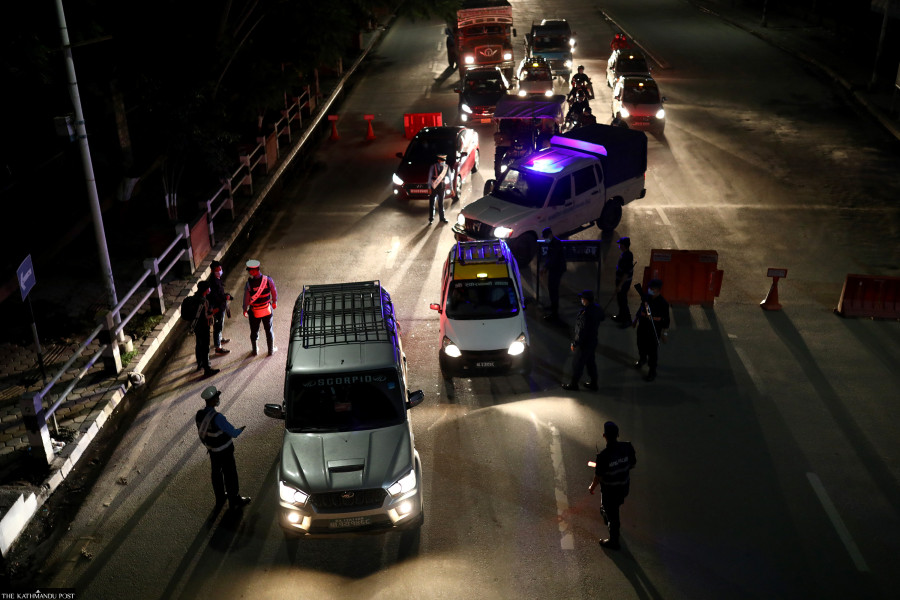Valley
Valley’s nighttime ban on vehicles criticised as impractical, short-sighted
Kathmandu’s chief district officer defends ban saying it will stop nighttime socialising and crowding.
Anup Ojha
The decision by the administrators of Kathmandu Valley to ban public and private vehicles, including two-wheelers, after 8pm starting Thursday has caused quite an uproar, with many criticising the move as short-sighted and impractical.
People have taken to social media to question the rationale for the ban.
Even a lawmaker from the ruling party on Thursday raised the issue in the House of Representatives.
Gagan Thapa, a Nepali Congress lawaker and former health minister, questioned the logic behind imposing a ban on vehicles plying after 8pm.
“Do infections increase in Kathmandu Valley and other areas after 8pm? And do they decrease in the morning?” Thapa asked the health minister of state from his own party, Umesh Shrestha. “Which study shows this?”
The authorities say they were forced to take the decision in the wake of increased mobility and socialising, as people were eating out in restaurants and partying, thus helping spread the coronavirus.
“We were forced to impose the ban because the increased mobility and socialising and eating out and partying at restaurants have increased the risk of coronavirus spread,” Kali Prasad Parajuli, chief district officer of Kathmandu, told the Post on Tuesday, the day the decision was made.
The Valley’s traffic police office says it will strictly implement the ban.
“If any public or private vehicle is found on the road after 8pm, we will impound them,” said Superintendent Sanjib Sharma Das, spokesperson for the Metropolitan Traffic Police Division. The ban however does not apply for vehicles used by essential services and people in emergency situations, according to Das.
He said 700 traffic police personnel will be deployed all across the Valley to monitor the ban.
But whether the move will help in containing the virus is contested by even public health experts. According to them, the risk of the coronavirus spreading is rather high during daytime rather than at night.
“I don’t think the new decision will make any difference when it comes to controlling the spread of the virus,” said Dr Sher Bahadur Pun, chief of the Clinical Research Unit at Sukraraj Tropical and Infectious Disease Hospital at Teku. “Because public mobility is high during the day, authorities should have focussed on other practical measures.”
Questions now have also arisen over how some working people could return home and how those who have their night duties can reach their offices.
Parajuli, the chief district officer, however, said those returning from work or heading for work would not be stopped.
“I have already communicated to the implementing agencies to not stop those returning home after work,” Parajuli told the Post on Thursday.
The authorities' decision to stop vehicular movements after 8pm appears to be largely aimed at discouraging night-time dining at restaurants and forcing them to close early.
Even though the prohibitory orders were relaxed on June 22 allowing restaurants to provide takeaway services, many restaurants have been allowing their patrons to sit and dine.
Parajuli admits that the decision to ban vehicular movement after 8pm was taken so as to stop the restaurants from operating beyond 7pm.
However, some say the decision is unwise, as the authorities should have better monitored and implemented the ban on dine-in services at restaurants, instead of introducing a blanket ban on vehicular movement.
The involvement of chief district officers in the pandemic-related decision-making process itself has been criticised. Public health experts and analysts told the Post last year that involving the chief district officers in such decisions was not only an unwise idea but also against the principles of federalism.
However, the government has continued to allow the chief district officers to impose Covid-related restrictions.
“We might announce a total ban anytime without any delay if the daily cases continue to surge,” Parajuli, the chief district officer of Kathmandu, said.
After the devastating second Covid-19 wave, daily cases had gradually declined, but infections are going up again.
On Thursday, the country reported a total of 3,260 new cases over the last 24 hours, of which 2,473 were from polymerase reaction tests.
Nepal’s Covid-19 death toll stands at 10,212 as of Thursday. There were 38,180 active cases.
Nepal has been vaccinating people after it started to receive doses from various sources, but the drive has remained sluggish as the country is yet to get enough jabs to scale up the campaign.
As of Thursday, 4,593,526 people (15.31 percent) have been vaccinated. As many as 2,922,240 people (9.74 percent) have been fully vaccinated.



 19.12°C Kathmandu
19.12°C Kathmandu.jpg)











